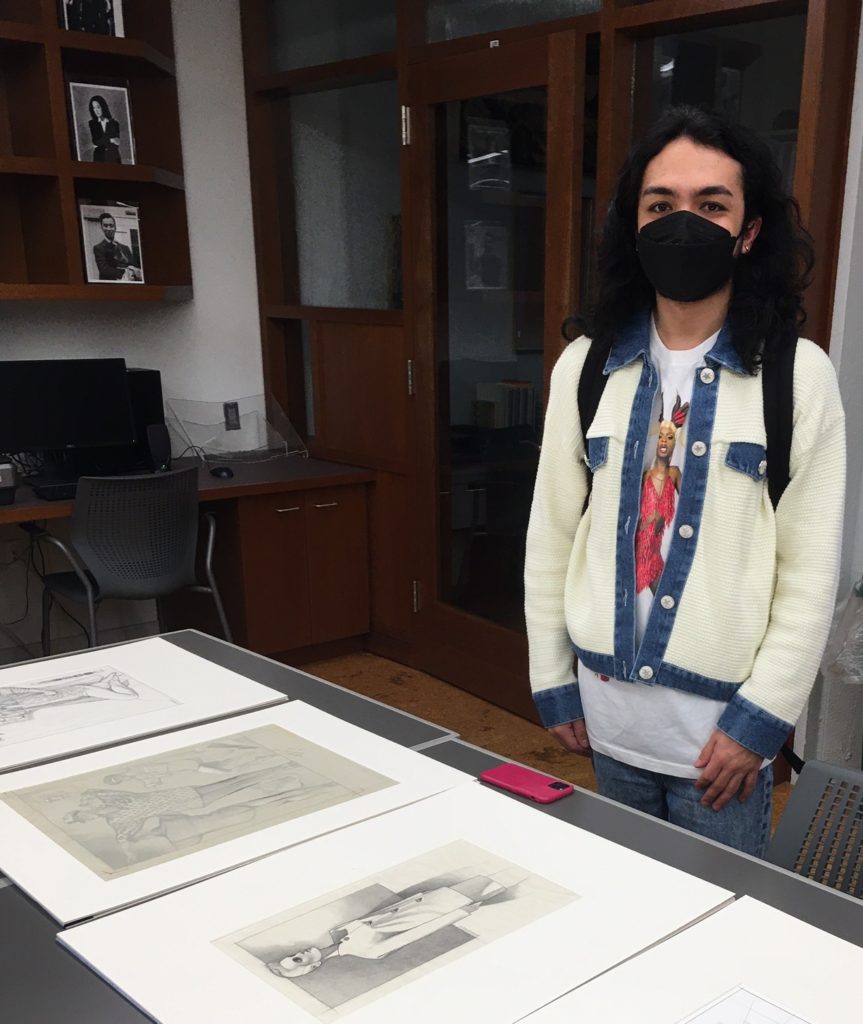By Richard Montañez, Sunday, March 20, 2022
This essay is written as an assignment for the AHMP senior class “Exhibitions” project ΜΟΔΑ IS FASHION. The exhibition is on display at the State University of New York’s FIT campus Gladys Marcus Library in Spring and Summer 2022.
Except for Brad Hamann’s Moonfall (2010), and a series of video interviews with his sisters, not too much has been written about the life and career of Greek American fashion illustrator George Stavrinos (1948–1990).
Stravrinos was born as the last of seven to parents who immigrated from Greece to near Boston in March 1948. Rising to great success in the 1970s and 80s, Stavrinos died of AIDS related complications in August 1990 at a hospital in New York City. Today, FIT’s Special Collections and College Archives (SPARC) houses some fourteen of his original illustrations. They entered SPARC through his friend, FIT Illustration Professor Rosemary Torre. Other original Stavrinos illustrations are kept at the Leslie Lohman Museum of Art in New York.
“My parents gave us a very European upbringing. …[…]… I went to Greek school after regular American school, where we were taught to read and write Greek …[…]… I served as an altar boy for seven years in the Greek Orthodox Church.” (Stavrinos, in an interview with Nathan Fain, 1978).
Well known in the world of commercial fashion illustration, Stavrinos produced works for the likes of Bergdorf Goodman, Barney’s, and The New York Times. He also crafted illustrations for Gentlemen Quarterly and Blueboy, referencing classic images of gay American erotica and lifestyle, often through representations of archetypal masculinity and handsomeness. Stavrinos visited relatives in Heraklion in Crete on at least one occasion in 1969 and 1970 before he moved permanently to New York City in 1973. Throughout his career, Stavrinos produced illustrations for magazines that were marketed toward gay men, openly referencing his own sexuality in a time of intense discrimination against LGBTQ+ people.

The illustration that I chose from his oeuvre is of a figure in a Charlotte Neuville suit, particularly because it is so androgynous in appearance. The illustration is from 1989 and was created only a few months before his death. The work is a testament to Stavrinos’ ability to confidently navigate different kinds of fashion and advertising spaces and their attitudes toward queerness or mixed gender expression. Not only does the figure emulate queerness through the garment they are wearing, but they also are sporting a non-conformist hairstyle which pushes this narrative further. This is particularly interesting when considering ideas about masculinity and homosexuality that can be traced all the way back to ancient Greece, a prominent part of Stavrinos’ heritage.
In his illustrations of both men and women, he utilized sources of inspiration such as Minoan, Archaic and Classical Greek sculptures and standards of beauty, which, at least for men, have been reproduced, reused, and recoded into gay culture for as long as homosexuality has existed. To my mind come the many surviving statues of Kouroi (young men), excavated in Greece and now on display in the National Archaeological Museum in Athens. One can almost imagine Stavrinos, who lived in a studio on a top floor corner apartment on 76 West 86th Street near Manhattan’s Central Park for many years, walking to the Metropolitan Museum of Art to draw the Greek kouros on display here since 1931.

Stavrinos’ images, particularly in erotica, can often depict displays of power, dominance, and in certain cases, invitation, which can change depending on the viewer and their own perception or fantasy of the image of the model. In this case, with a more femme-presenting figure, it becomes especially clear that they are purposely constructed to be more stoic or solid in appearance to emulate a certain kind of masculinity within women.
In 21st century contexts, we now have a clear understanding that menswear or references to menswear are not automatically indicative of power and agency within anyone, but Stavrinos’ illustrations exude timelessness regardless. In considering what were more personal aspects about his life and why he drew the subjects that he did, the subtle choices that were made in his commercial works are reminders of the influence queer life had on him during his lifetime and how they inspired him to continue working.

Acknowledgments
I am grateful to April Callahan, Curator of Manuscript Collections and Associate at the Special Collections and Archives (SPARC), Gladys Marcus Library at FIT, who facilitated access to the original drawings of Stavrinos.
Further Reading
Hamann, Brad. 2010. Moonfall. The Life and Art of George Stavrinos. Based on the author’s M.F.A. Visual Arts Graphic Design thesis at Marywood University.
Fain, Nathan. 1978. “George Stavrinos, Illustrator,” Christopher Street, November 1978, 16–25.
Kaltsas, Nikos. 2002. Sculpture in the National Archaeological Museum, Athens. Los Angeles: J. Paul Getty Museum.
Richter, Gisela and Irma Richter. 1936. “The Archaic ‘Apollo’ in the Metropolitan Museum.” Metropolitan Museum Studies, 5 (1934–1936), 20–57.
Stavrinos. Clarity of Vision. Stavrinos’ sisters Venetia, Sandra and Debbie talk about the love and admiration they had for their brother (the video is accessible on youtube here).
About the Author

Richard Montañez is a senior in the AHMP program at FIT. His interests include queer art history, the decolonization of museums, and curatorial artists.
Current Favorite Reading or Art Exhibition
“Faith Ringgold: American People” The New Museum, New York City, February 17, 2022 to June 5, 2022.